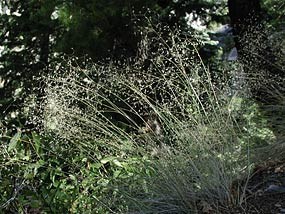
(Brandon Kowallis) Grasses are linear plants with slender leaves. Although often unnoticed, grasses play an important role in both human and animal lives. All grains that humans eat such as wheat, oat, corn, and rice come from grasses. Wildlife such as deer and elk eat the leaves as their primary diet and the roots of grasses keep precious soil from washing away. Bluebunch Wheatgrass: This plant is a blue-green grass that grows in bunches sending off long stalks with rows of seeds. It grows on dry hillsides where it gets plenty of sun. Ranchers have historically fed their cattle on Bluebunch Wheatgrass and it is a great source of food for wildlife too. Muttongrass: This plant is a shorter grass that has clusters of small silvery pink flowers. It grows along the entire trail leading to the cave. This grass has also been traditionally used for grazing. The name shows the value shepherds place on this grass for sheep feed. Indian Ricegrass: This plant is a delicate, airy, grass that has been slowly disappearing from the west due to overgrazing. This grass was once used by Native Americans to make bread, especially when the corn crop failed. Today it is found in dry harsh environments along the cave trail that have not been overly disturbed by human contact. Indian Ricegrass is |
Last updated: March 13, 2023
